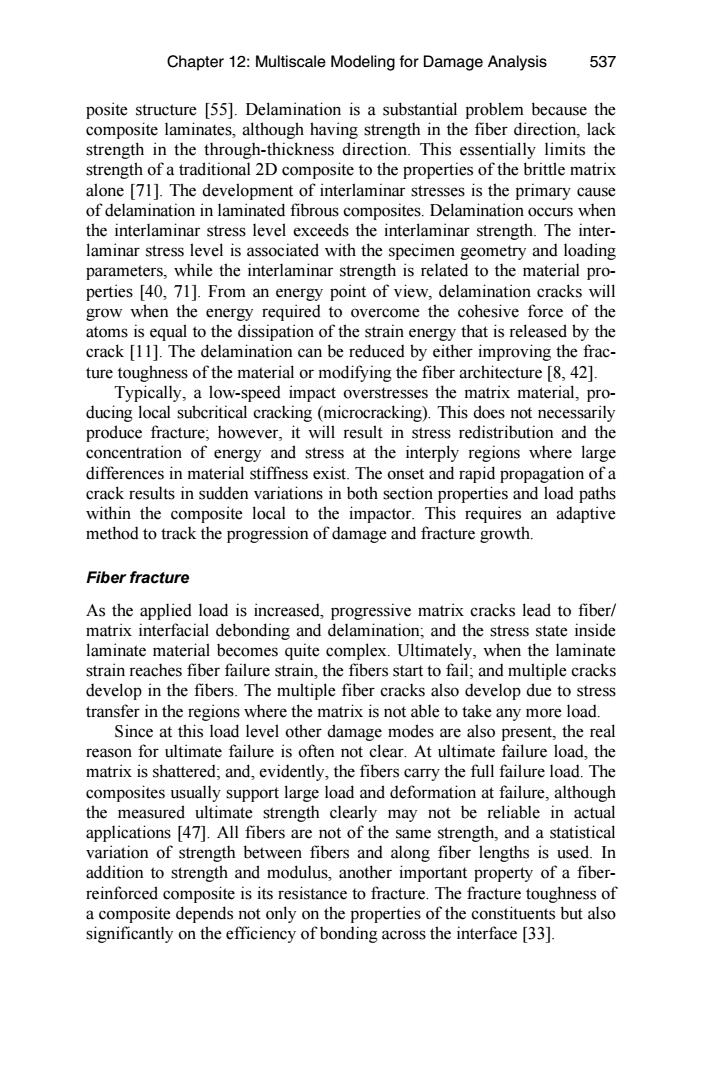正在加载图片...

Chapter 12:Multiscale Modeling for Damage Analysis 537 posite structure [55].Delamination is a substantial problem because the composite laminates,although having strength in the fiber direction,lack strength in the through-thickness direction.This essentially limits the strength of a traditional 2D composite to the properties of the brittle matrix alone [71].The development of interlaminar stresses is the primary cause of delamination in laminated fibrous composites.Delamination occurs when the interlaminar stress level exceeds the interlaminar strength.The inter- laminar stress level is associated with the specimen geometry and loading parameters,while the interlaminar strength is related to the material pro- perties [40,71].From an energy point of view,delamination cracks will grow when the energy required to overcome the cohesive force of the atoms is equal to the dissipation of the strain energy that is released by the crack [11].The delamination can be reduced by either improving the frac- ture toughness of the material or modifying the fiber architecture [8,421. Typically,a low-speed impact overstresses the matrix material,pro- ducing local subcritical cracking (microcracking).This does not necessarily produce fracture;however,it will result in stress redistribution and the concentration of energy and stress at the interply regions where large differences in material stiffness exist.The onset and rapid propagation of a crack results in sudden variations in both section properties and load paths within the composite local to the impactor.This requires an adaptive method to track the progression of damage and fracture growth. Fiber fracture As the applied load is increased,progressive matrix cracks lead to fiber/ matrix interfacial debonding and delamination;and the stress state inside laminate material becomes quite complex.Ultimately,when the laminate strain reaches fiber failure strain,the fibers start to fail;and multiple cracks develop in the fibers.The multiple fiber cracks also develop due to stress transfer in the regions where the matrix is not able to take any more load. Since at this load level other damage modes are also present,the real reason for ultimate failure is often not clear.At ultimate failure load,the matrix is shattered;and,evidently,the fibers carry the full failure load.The composites usually support large load and deformation at failure,although the measured ultimate strength clearly may not be reliable in actual applications [47].All fibers are not of the same strength,and a statistical variation of strength between fibers and along fiber lengths is used.In addition to strength and modulus,another important property of a fiber- reinforced composite is its resistance to fracture.The fracture toughness of a composite depends not only on the properties of the constituents but also significantly on the efficiency of bonding across the interface [33].posite structure [55]. Delamination is a substantial problem because the composite laminates, although having strength in the fiber direction, lack strength in the through-thickness direction. This essentially limits the strength of a traditional 2D composite to the properties of the brittle matrix alone [71]. The development of interlaminar stresses is the primary cause of delamination in laminated fibrous composites. Delamination occurs when the interlaminar stress level exceeds the interlaminar strength. The interlaminar stress level is associated with the specimen geometry and loading parameters, while the interlaminar strength is related to the material properties [40, 71]. From an energy point of view, delamination cracks will grow when the energy required to overcome the cohesive force of the atoms is equal to the dissipation of the strain energy that is released by the crack [11]. The delamination can be reduced by either improving the fracture toughness of the material or modifying the fiber architecture [8, 42]. Typically, a low-speed impact overstresses the matrix material, producing local subcritical cracking (microcracking). This does not necessarily produce fracture; however, it will result in stress redistribution and the concentration of energy and stress at the interply regions where large differences in material stiffness exist. The onset and rapid propagation of a crack results in sudden variations in both section properties and load paths within the composite local to the impactor. This requires an adaptive method to track the progression of damage and fracture growth. Fiber fracture As the applied load is increased, progressive matrix cracks lead to fiber/ matrix interfacial debonding and delamination; and the stress state inside laminate material becomes quite complex. Ultimately, when the laminate strain reaches fiber failure strain, the fibers start to fail; and multiple cracks develop in the fibers. The multiple fiber cracks also develop due to stress transfer in the regions where the matrix is not able to take any more load. Since at this load level other damage modes are also present, the real reason for ultimate failure is often not clear. At ultimate failure load, the matrix is shattered; and, evidently, the fibers carry the full failure load. The composites usually support large load and deformation at failure, although the measured ultimate strength clearly may not be reliable in actual applications [47]. All fibers are not of the same strength, and a statistical variation of strength between fibers and along fiber lengths is used. In addition to strength and modulus, another important property of a fiberreinforced composite is its resistance to fracture. The fracture toughness of a composite depends not only on the properties of the constituents but also significantly on the efficiency of bonding across the interface [33]. Chapter 12: Multiscale Modeling for Damage Analysis 537